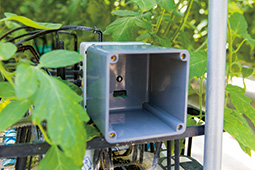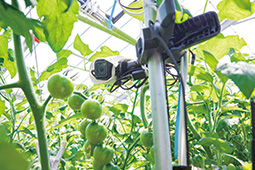INDEX

A sensor used to measure the conditions within the greenhouse 
A camera used to record the movement of the plants’ leaves
November 2020
AI Assists Cultivation of Sweet Tomatoes

A research group led by Shizuoka University Professor Mineno Hiroshi has developed a system that applies artificial intelligence to provide stable yields of high-quality sweet tomatoes.

In recent years, IoT (Internet of things), robots and AI (artificial intelligence) are increasingly being applied in the field of agriculture. Shizuoka University Professor Mineno Hiroshi, who specializes in research on communication systems and sensor networks, has developed a system that uses AI to determine the best time to water plants to support their growth and productivity.
Development of the system was inspired by a project conducted with Shizuoka Prefectural Research Institute of Agriculture and Forestry beginning in 2013.
“Our goal was to increase the harvest volume of tomatoes by 30% by administering the appropriate amount of a nutrient solution needed for growth through the use of sensor network technology,” Professor Mineno explains. “We were not able to increase the harvest volume; however, we were able to produce high-quality tomatoes with a high sugar content.”
Tomatoes do not grow to their full size potential when the plants are underwatered, but their components become more concentrated, sugar content rises and the fruit becomes sweeter. This method of cultivating tomatoes with a high sugar content was well known among experts. However, the method is hard on the tomato plants, and if the amount of water supplied is too low, the plant may grow slowly or wither. It is said to take ten years to master the watering of plants, because it requires skill to determine a plant’s precise state of growth and the best time and amount of water to give it to keep the plant from withering.

“Skilled farmers carefully check the color and tension of the tomato plant’s leaves to determine the right amount of water to give it. I thought that if we applied their experience and intuition to numbers and were able to have a computer learn this data, then it would be possible not only to pass on high-quality know-how of cultivation that isn’t being passed on due to a shortage of workers, but also improve this knowledge.”
Plants absorb water through their roots and evaporate the majority of it through pores in their leaves. If the amount of water absorbed sufficiently covers the amount lost through this process of transpiration, then the leaves will be healthy, but if there is not enough, the leaves will wilt. Professor Mineno theorized that “we could determine the appropriate timing for watering if we could quantify the wilting state of the leaves.”
He placed a camera in the greenhouse and programmed it to take photographs every minute. In this way, he was able to record the subtle movements of the leaves when wilting. By having AI learn this data in addition to data on temperature, humidity, brightness and other environmental factors, Professor Mineno developed a system that could automatically adjust the timing of watering by detecting the state of wilting in the tomato plants. Gaining the support of vegetable wholesaler Happy Quality and other companies in Fukuroi City, Shizuoka Prefecture, they were able to achieve the stable harvesting of high sugar content tomatoes as well as prevent splitting in the fruit.

“In addition to monitoring lighting and other indirect factors, the key feature of our system is that it can determine the timing of watering by observing the plant itself,” says Professor Mineno. “Using this system, tomato growers whatever their experience can administer watering at the best time for the plants, regardless of the differences in the growing medium or cultivation environment. We are currently conducting repeat experiments in different regions and environments to test this prior to commercializing the system.”
A number of companies are said to be interested in providing the system as a package that includes sensors, cameras and the equipment needed to control the best time for watering. Professor Mineno, who hopes to release the system some time in 2021, says that we can expect similar developments for cantaloupes, strawberries, leafy vegetables and more in the future.
“Given the shortage of workers and the aging of society, agriculture can become a stable and sustainable industry if value-added produce can be easily produced by anyone through the use of AI. We hope to support agriculture with the concept of conversing with plants using AI technology.”

